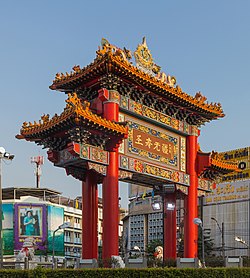Samphanthawong district
Khet in Bangkok, Thailand From Wikipedia, the free encyclopedia
Khet in Bangkok, Thailand From Wikipedia, the free encyclopedia
Samphanthawong (Thai: สัมพันธวงศ์, pronounced [sǎm.pʰān.tʰā.wōŋ])) is one of the 50 districts (khet) of Bangkok, Thailand. Regarded as Bangkok's Chinatown, it is the smallest district by area in Thailand. Neighboring districts are (from north clockwise) Pom Prap Sattru Phai, Bang Rak, Khlong San (across Chao Phraya River), and Phra Nakhon.
This article is written like a travel guide. (February 2020) |
Samphanthawong
สัมพันธวงศ์ | |
|---|---|
| Other transcription(s) | |
| • Teochew | 三攀他翁[i] Sam-phang-tha-ong (Pe̍h-ūe-jī) Sam1pang1ta1ong1 (Peng'im) Sānpāntāwēng (Hanyu Pinyin) |
 | |
| Nickname: Chinatown | |
 District location in Bangkok | |
| Coordinates: 13°43′53″N 100°30′51″E | |
| Country | Thailand |
| Province | Bangkok |
| Seat | Talat Noi |
| Khwaeng | 3 |
| Area | |
| • Total | 1.416 km2 (0.547 sq mi) |
| Population (2017) | |
| • Total | 24,150[2] |
| • Density | 17,055/km2 (44,170/sq mi) |
| Time zone | UTC+7 (ICT) |
| Postal code | 10100 |
| Geocode | 1013 |
The area has been a Chinese community since the early days of Bangkok. Originally living in what is now the Phra Nakhon district, they were relocated here when the capital was set up. The narrow Sampheng Lane (สำเพ็ง, now called Wanit I Road, วานิช 1) was the district's main street until Yaowarat Road was constructed in 1892 during the reign of King Chulalongkorn. Sampheng Lane is depicted on the back of series 15 20 baht banknotes, to commemorate an important post-World War II visit by young king Rama VIII[3] (accompanied by HM's brother, Prince Bhumibol, with his ever-present camera). Nowadays, Yaowarat Road remains the heart of Bangkok's Chinatown.
The area now in the Samphanthawong district was once three separate amphoes, Samphanthawong, Sam Yaek, and Chakkrawat, established on 15 October 1915 when old districts were overhauled and replaced by 25 new districts to cover inner Bangkok. Sam Yaek District and Chakkrawat District were later merged into Samphanthawong District. The district became Khet Samphanthawong in 1972. It is believed that the name Samphanthawong was derived from Wat Samphanthawongsaram, the temple near the district office when it was first built. Now the district office has moved to Yotha Road in Talat Noi Sub-district.
The district is divided into three sub-districts (khwaeng).
| No. | Name | Thai | Area (km2) | Population (Dec 2023) | Density (Dec 2023) | Map |
|---|---|---|---|---|---|---|
1. | Chakkrawat | จักรวรรดิ | 0.484 | 5,886 | 12,161.16 |  |
2. | Samphanthawong | สัมพันธวงศ์ | 0.483 | 7,324 | 15,163.56 | |
3. | Talat Noi | ตลาดน้อย | 0.449 | 6,336 | 14,111.36 | |
| Total | 1.416 | 19,546 | 13,803.67 | |||

Yaowarat Road (เยาวราช) is about 1.5 km in length. Along both sides, gold shops and Chinese restaurants: noodles, rice, dim sum, bird's nest soup are found. More shops, especially those selling fruit and Chinese traditional medicine, can be found in the small lanes branching off the main road. A gate was built to celebrate King Bhumibol's 72nd birthday. It is on Odeon Circle, (named after a cinema that once stood nearby) at end of Yaowarat Road.


Some of well-known Thai Buddhist Temples in the district are:
Many Chinese temples and shrines are also here, including:
The most famous Chinese temple in the area, Wat Mangkon Kamalawat (วัดมังกรกมลาวาส), popularly known as Wat Leng Noei Yi (วัดเล่งเน่ยยี่), lies just outside the Samphanthawong boundary in the neighboring Pom Prap Sattru Phai District.

There are other places of historic interest in Samphanthawong. Wat Mae Phra Luk Prakham (วัดแม่พระลูกประคำ) or Holy Rosary Church, on the bank of Chao Phraya River, is one of the oldest Catholic churches in Bangkok. It is more widely known by its older name, Wat Kalawar (วัดกาลหว่าร์), named after Calvary. It was first built in 1787 during King Rama I period by settlers who migrated from Ayuthaya when the city was lost to Burma. The current building was constructed in 1890.
Upriver from the church is Thailand's first commercial bank building. The building was constructed in 1904 and houses the Talat Noi Branch of Siam Commercial Bank. Downriver from Holy Rosary Church is River City Shopping Complex, a shopping center specializing in arts and antiques.
There are numerous markets around Samphanthawong. There are many shops and stalls along Yaowarat, Sampheng (now Wanit 1), and Charoen Krung Roads, especially at night and during weekends. Saphan Lek, the older name of the bridge crossing Khlong Ong Ang canal on Charoen Krung Road, is a narrow strip along both sides of Khlong Ong Ang with small shops selling goods. Nearby is Woeng Nakhon Khasem (เวิ้งนาครเขษม) or "thieves market". The Khlong Thom Market (in Pom Prap Sattru Phai District), once a famous market for low cost goods and electronics, is a large area of several blocks on the opposite side of Charoen Krung Road. The small lanes inside the blocks were fully packed with stalls operating on Saturday nights till Sunday mornings, but it is now closed as part of a pavement cleanup campaign in March 2015.[4][5]
Several Chinese festivals are held here yearly. Yaowarat Road is often closed to traffic during these periods.
Seamless Wikipedia browsing. On steroids.
Every time you click a link to Wikipedia, Wiktionary or Wikiquote in your browser's search results, it will show the modern Wikiwand interface.
Wikiwand extension is a five stars, simple, with minimum permission required to keep your browsing private, safe and transparent.